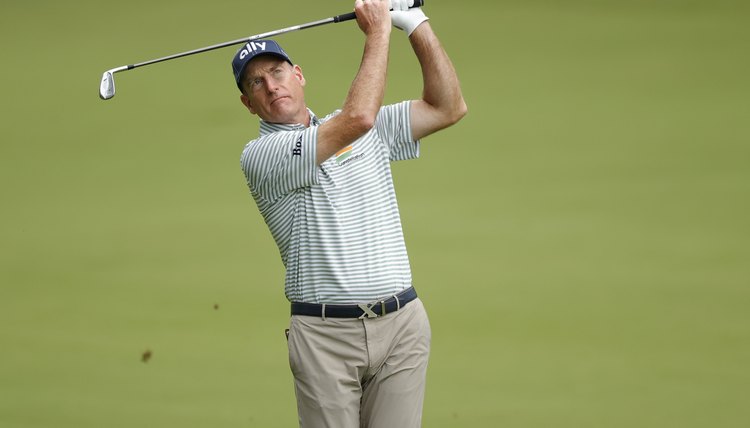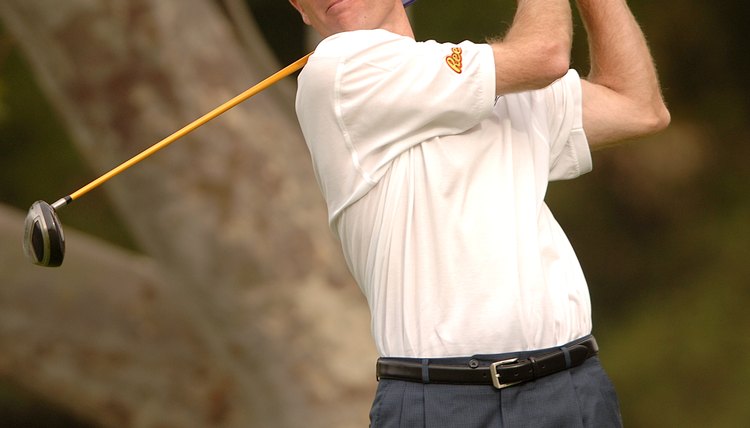What Are the Benefits of the Double Overlap Golf Grip? (With Video)

If you search the Internet for “double-overlap grip,” chances are good that you will get a lot of hits for the words “overlap” and “grip”… and virtually no useful information on the double-overlap golf grip itself. But the golf club grip is used by a few successful professional golfers, like PGA Tour pro Jim Furyk, so it is worth understanding why many prefer this type of grip. It’s a lot different than the standard interlocking grip used by Tiger Woods or Jack Nicklaus or even the baseball grip that some use, but it offers some benefits when driving, chipping, and putting. Here's how you can improve your golf swing with the double overlap grip.
Unified Hands
The more common overlap grip, also known as the Vardon grip, overlaps the pinky finger of the right hand over the left index finger. This can lead to one hand feeling more dominant than the other during the backswing. This often leads to an uneven grip for many beginners.
Furyk’s double-overlap is the best grip for an even swing because it overlaps both the right pinky and ring fingers over the left index and middle fingers. This creates a compact grip; the wrists are extremely close to each other and can function more as a unit. This minimizes the chance for one hand to “take over” the swing or when using your putter.
Left-Hand Control

The start point for most beginners is learning a grip option that feels most comfortable.
Feel is a crucial part of any golfer’s swing. Although we do most things by feel, most weekend players struggle to feel their swing in a consistent way from day-to-day.
The double-overlap grip prevents the right hand from having any major contact with the grip of the club, almost forcing a golfer to feel as if his swing is being controlled totally by his left hand and the left side of his body. This grip style reinforces a more consistent feel each time he plays. It can be awkward during a putting grip or a downswing but it serves as a reminder that your grip is consistent throughout your golf game.
Minimize Hooks
Many golfers struggle against a hook, which is generally caused by flipping the right hand at the moment they contact the ball. The double overlap is one of the best golf ten finger grips for keeping the clubhead and the clubface from being moved and preventing the golf ball from flying out of play.
By placing the left hand in such a dominant position, a double-overlap grip prevents the right hand from “taking over” as referred to earlier. Because of this, Furyk generally plays a controlled fade, which is a left-to-right shot. Amateur golfers might not get the perfect fade during their full swing but this common grip should help ensure your shots stay in the fairway.
Encourage a Swing

The start point for most beginners is learning a grip option that feels most comfortable.
Short-game guru Dave Pelz has mentioned using the double-overlap grip over the interlock golf grip during pitching practice to encourage lighter pressure when using your regular grip.
Because the right hand can only support the left hand in a double-overlap grip--it is unable to apply its grip pressure directly to the club--it becomes harder for the player to hit at the ball. He is forced to let the club do more of the work, which teaches him a more flowing swing that takes less effort.
Learn to Let Go
If you try the double-overlap grip, your most likely reaction will be one of helplessness. No matter how hard you try, you cannot escape the feeling that you do not have full control of the club.
Even if you decide not to use the grip during a round, practicing with it can help you learn to just let go and swing the club. It can help you develop more flow and rhythm, as well as showing you just how little effort it takes to get solid contact with the ball. Swinging with the double-overlap grip can help you learn to just swing the club, and for most players, that might be its greatest benefit.
Writer Bio
Blaise is a Freshman at the University of Missouri, studying Journalism at the world-renowned J school. He is the host of the Fast Five Podcast with his Childhood friend Sam Sinclair and interns with the Sports AI platform Pine Sports. He is a huge fan of the Kansas City Chiefs and the St Louis. Cardinals and hopes to cover them professionally in his near future.
